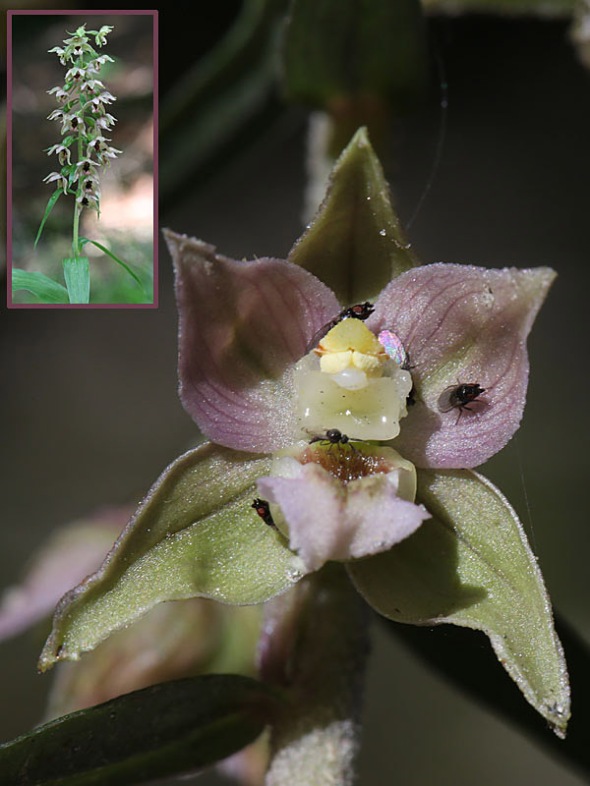Helleborine Drugs Its Visitors
 Helleborine (Epipactis helleborine) is a common woodland plant which is easily overlooked due to its inconspicuous, small, greenish-purple flowers. However, this modest member of the Orchid family brings pollination to a new level. Its structure is said to not be morphologically attractive to insects, so Helleborine has come up with another strategy to get its flowers pollinated. It produces nectar that contains several chemicals, including oxycodone, a drug which has a morphine-like effect on organisms that ingest it. When insects drink the oxycodone-laced nectar, they become sluggish, which prolongs the amount of time they spend at the flower, which, in turn, increases the chances that the flower will be pollinated.
Helleborine (Epipactis helleborine) is a common woodland plant which is easily overlooked due to its inconspicuous, small, greenish-purple flowers. However, this modest member of the Orchid family brings pollination to a new level. Its structure is said to not be morphologically attractive to insects, so Helleborine has come up with another strategy to get its flowers pollinated. It produces nectar that contains several chemicals, including oxycodone, a drug which has a morphine-like effect on organisms that ingest it. When insects drink the oxycodone-laced nectar, they become sluggish, which prolongs the amount of time they spend at the flower, which, in turn, increases the chances that the flower will be pollinated.


















question: are you sure on the oxycodone? that’s a semi-synthetic opioid and I don’t believe it exists naturally.
July 29, 2013 at 12:21 pm
This information comes from National Geographic, so I trust it, but I have read elsewhere that it is semi-synthetic…not sure what to think, but thank you for pointing this out.
July 29, 2013 at 12:45 pm
Fascinating Mary. Is this the only species of small orchid that looks like this? We have some around our house that looks identical to the photo, but I was not sure if I can use this as finally knowing what this orchid is, or whether there are many similar species in the genus so I need to look into it more?
July 30, 2013 at 2:03 pm
Hi Craig,
There are about 70 species of Epipactis, but none that I know of that resemble Epipactis helleborine closely enough to be mistaken for it. Helleborine is invasive, so it’s likely that if you have numerous plants near you, and they look like Helleborine, they probably are Helleborine!
July 30, 2013 at 7:50 pm
My goodness you guys are really stuck in your theoretical heads are you not? A substance is semi synthetic? until we find it naturally occuring, or synthesised by a plant, then it ceases to be semi synthetic?, they found a tree with tramadol in it too recently, the reason we dont find is we seldom look, as we have done everything to downplay the super sophisticated labs in sessile organisms and up play our crude games with subsidized oil, why ? think patents think $
a blade of grass has more happening chemically in more efficient solar powered non pollutive ways, carried out with more precision and accuracy or tighter thresholds than every university chemical lab combined…..wake up and get over it ….or better still learn to harness it for the chemistry of the future
I give you a little bet that if you know where to look and when to look you will find practically everything we have made in a lab and biliions, trillions times more than this in just one coral reef, but that aint going to get you a job at pfizer or on capitol hill
August 27, 2014 at 5:22 pm
Since the morphine & primarily oxycodone alkaloids are produced in the flower nectar we should set up green houses to produce a mono floral honey via controlled apiary bee hives. Then we can test the Epipactis helleborine Honey.
Since this species naturally is invasive & hardy capable of survival in colder climates as potential source for opiate pain killer such is wonderful. One could gather up the nectar rich flowers & place them in a bottle of vodka or other high proof alcohol as a means of extracting the nectar. One must question how many of the flowers of this entheogen must one consume for a proper dosing.
Either way I imagine this will make one hell of a fine mono floral Honey.
February 16, 2018 at 11:50 pm